Low-TRL and application-driven research in collaboration with academia, industrial partners and agencies for boosting technological advance in electronic, electromagnetic and optical technologies in several domains, ranging from Space-borne applications to industrial sensors.
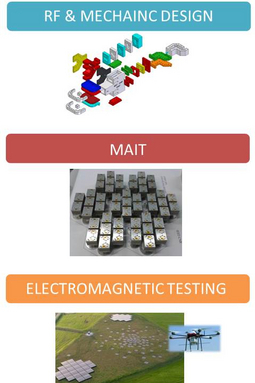
Microwave, Millimeter-Wave and Sub-Terahertz Technologies
The CNR-IEIIT expertise in the field of microwave, millimeter-wave and sub-terahertz technologies include modelling, design, manufacturing and experimental characterization of antennas and passive devices/systems operating from a few Megahertz to hundreds of Gigahertz for several application domains, including SatCom, Earth Observation, Space Science, and industrial sensing. Ad-hoc electromagnetic modelling tools are developed for the efficient and accurate design of high-performance antennas and waveguide components through differential and integral formulations. The electromagnetic and mechanical design is oriented to meet the RF performance required in the applications, while achieving a robust mechanical layout customized to the manufacturing technology (both standard machining and additive manufacturing processes). The known-how acquired in the field of calibration and measurement techniques is applied to the accurate electromagnetic characterization of complex DUTs (e.g., multi-band, multi-port and multi-mode systems) and to the on-site radiation-pattern measurements of large antenna arrays through UAVs.
References:
- F. Paonessa et al., “Design and Verification of a Q-Band Test-Source for UAV-Based Radiation Pattern Measurements”, IEEE Transactions on Instrumentation and Measurement (2020).
- G. Addamo et al., “3D Printing of High-Performance Feed Horns from Ku to V Bands”, IEEE Antennas and Wireless Propagation Letters (2018), DOI: 10.1109/LAWP.2018.2859828
- G. Virone, et al., “Strong Mutual Coupling Effects on LOFAR: Modeling and In Situ Validation”, IEEE Transactions on Antennas and Propagation (2018), DOI: 10.1109/TAP.2018.2816651
- O. A. Peverini et al., “Selective Laser Melting Manufacturing of Microwave Waveguide Devices”, Proceedings of the IEEE (2017), DOI: 10.1109/JPROC.2016.2620148
Laboratories: Microwaves and Millimeter-Waves
Infrastructure Facilities: Sub-Terahertz Design and Testing
Current Projects: STUNT | CHILLI | CIMR B2/C/D | MetOp-SG MWI | PAckMan | CIMR A/B1 | GSTP-AM | AMLETO | LSPE
Completed Projects: SKA
Vertical Cavity Surface Emitting Lasers: comprehensive multiphysics models
Vertical Cavity Surface Emitting Lasers (VCSELs) is a pervasive and enabling technology IIT world. These micrometer scale lasers (see scheme in figure, top-left) are used in hundreds of pieces as sensors in latest generation iphones and will soon reach the PCs as replacements of intra end inter-board electrical communications. The CNR-IEIIT expertise in the field of VCSELs dates to more than twenty years ago, pioneering the techniques to achieve polarization stable emission and is recognized worldwide, attracting several institutions/industries for collaborations. The latest progress is a multiphysics model, the VENUS package; it integrates and makes interacting the electrical, optical, thermal and gain models needed for a comprehensive device simulation (see figure, top-right). All the software is developed in house. Starting from a detailed description of all the hundreds of layers and details, VENUS is able to predict the performance of state of the art VCSELs [1], with excellent agreement with experiments (see figure, bottom): V-I (current), Light-I, wavelenght-I, resitence-I.
Ongoing activities on: tunnel-junction 850nm VCSEL [2], tuneable liquid-crystal VCSELs for optical tomography and Wavelengh Division Multiplexing [3], overcoming actual speed limits by polarization modulation [4].
References:
- [1] P. Debernardi et al., “Probing Thermal Effects in VCSELs by Experiment-Driven Multiphysics Modeling”, IEEE Journal of Selected Topics in Quantum Electronics, 2019, 25(6), 2927580.
- [2] A. Tibaldi, P. Debernardi et al. “Analysis of carrier transport in tunnel-junction vertical-cavity surface-emitting lasers by a coupled nonequilibrium green's Function-Drift-Diffusion Approach”, Physical Review Applied, 2020, 14(2), 024037
- [3] B. Boisnard, M. Alouini, P. Debernardi, et al., ”CW Operation of a Tunable 1550-nm VCSEL Integrating Liquid-Crystal Microcells”, Photonics Technology Letters, 2020, 32(7), pp. 391-394.
- [4] T. Pusch, P.Debernardi et al. “Vertical-cavity surface-emitting laser with integrated surface grating for high birefringence splitting” Electronics Letters, 2019, 55(19), pp. 1055-1057.
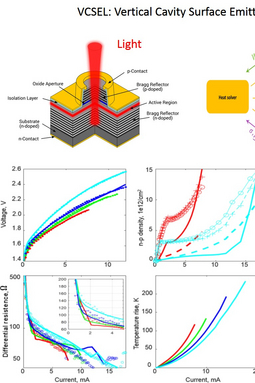
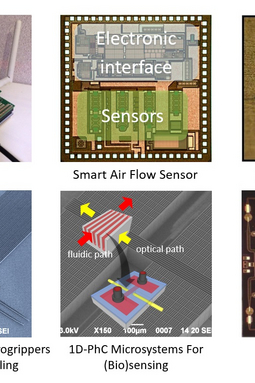
Electronics and Micro-electronics
The expertise includes the thematic area of Smart sensors and concerns the design, fabrication and experimental characterization of micro-nanosensors/MEMS integrated on the same chip with the electronic interface necessary for the signal acquisition and processing. The micro-nano-structuring of silicon (porous silicon) and the use of new materials (e.g. polymers), in conjunction with standard microelectronic technologies are key elements for the development of a new class of devices with improved sense capabilities and easy integration (both hardware and software) with most common IC components. Further skills involve the design, fabrication and experimental characterization of microwave active circuits (e.g. power amplifiers) and power electronic converters able to feed electronic devices, to drive actuators and to supply power to smart electronic systems for a reliable interaction with the real world.
Laboratories: Electronics and Micro-electronics
Infrastructure Facilities: Electronic Design and Measurements
Passive Remote Sensing
The expertise embraces the broad area of passive remote sensing, including Earth observation, atmospheric sounding and imaging, and electromagnetic modelling of thermal emission. Remote sensing by passive sensors is explored making reference to different platforms (e.g., satellite, airborne, UAV, ground-based) and different sensor technologies, ranging from multi/hyperspectral sensors to microwave radiometers.
Within the hyperspectral imaging arena, advanced signal and image processing methodologies are developed to address different Earth observation challenges such as image segmentation, land-cover classification, spectral anomaly and material detection and target recognition.
The main advantages of microwave radiometry with respect to other techniques are the different sensitivity to the water content in both liquid and gaseous phase, the almost all-weather availability, and the relative low noise in the measurements.
Ground-based radiometers are used to investigate the sky thermal emissions to retrieve geophysical observables such as the total amount of water vapor (PWV), the non-precipitating cloud liquid content (LWC) and the zenith wet delay (ZWD). These atmospheric parameters are useful in several fields such as global and climate change, radio astronomy study, and space geodesy.
References:
- Matteoli, S., Diani, M., Corsini, G., Closed-Form Nonparametric GLRT Detector for Subpixel Targets in Hyperspectral Images, IEEE Transactions on Aerospace and Electronic Systems, 56 (2), art. no. 8804215, pp. 1568-1581, 2019.
- Theiler, J., Ziemann, A., Matteoli, S., Diani, M., Spectral variability of remotely sensed target materials: Causes, models, and strategies for mitigation and robust exploitation, IEEE Geoscience and Remote Sensing Magazine, 7 (2), pp. 8-30, 2019.
- Bosisio, AV; Macelloni G.; Brogioni M., Evaluation of the Atmospheric Upward Thermal Emission Towards SSS Retrieval at L Band, in Earth observation advancements in a changing world (editors: Gherardo Chirici and Marco Gianinetto) AIT Series Trends in Earth Observation - Volume 1
- Bosisio, AV; Graziani, A; Mattioli, V; Tortora, P. , On the Use of Microwave Radiometers for Deep Space Mission Applications by Means of a Radiometric-Based Scalar Indicator, IEEE Journal of Selected Topics in Applied Earth Observations and Remote Sensing,8(7), pp.4336-4344, 2015.
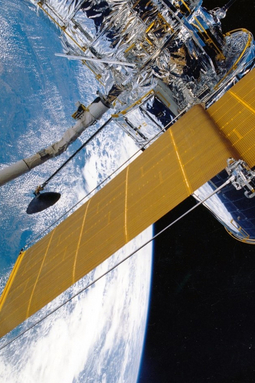
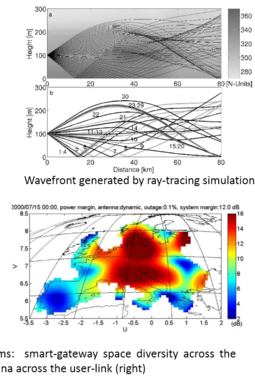
Radio Propagation
Wave propagation is a key building block of every wireless telecommunication system. IEIIT skills in this area include:
- Channel modeling for Earth-Space systems
- Simulation and modeling of the terrestrial propagation channel for fixed and mobile applications
- Fade mitigation techniques for advanced satellite systems operating in the Ka-, Q/V-, W- and optical bands
The above activities are being carried out in scientific projects funded by ASI, ESA or in the frame of European research networks (SATNEX, COST).
Current Projects: RadioSatMet
Completed Projects:MOPRAM